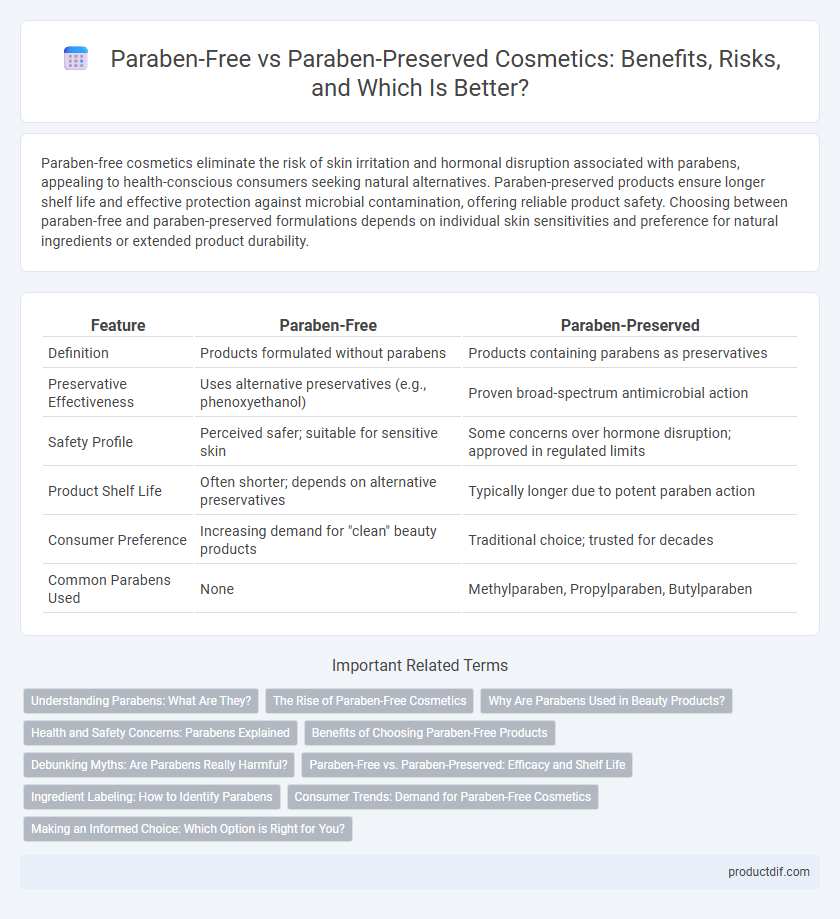Paraben-free cosmetics eliminate the risk of skin irritation and hormonal disruption associated with parabens, appealing to health-conscious consumers seeking natural alternatives. Paraben-preserved products ensure longer shelf life and effective protection against microbial contamination, offering reliable product safety. Choosing between paraben-free and paraben-preserved formulations depends on individual skin sensitivities and preference for natural ingredients or extended product durability.
Table of Comparison
| Feature | Paraben-Free | Paraben-Preserved |
|---|---|---|
| Definition | Products formulated without parabens | Products containing parabens as preservatives |
| Preservative Effectiveness | Uses alternative preservatives (e.g., phenoxyethanol) | Proven broad-spectrum antimicrobial action |
| Safety Profile | Perceived safer; suitable for sensitive skin | Some concerns over hormone disruption; approved in regulated limits |
| Product Shelf Life | Often shorter; depends on alternative preservatives | Typically longer due to potent paraben action |
| Consumer Preference | Increasing demand for "clean" beauty products | Traditional choice; trusted for decades |
| Common Parabens Used | None | Methylparaben, Propylparaben, Butylparaben |
Understanding Parabens: What Are They?
Parabens are a class of synthetic preservatives commonly used in cosmetic products to prevent the growth of harmful bacteria and mold, ensuring product safety and longevity. These compounds, including methylparaben, ethylparaben, propylparaben, and butylparaben, mimic estrogen and have raised concerns due to potential hormone disruption and links to health issues. Understanding the role of parabens is crucial when choosing between paraben-free options that avoid these synthetic chemicals and paraben-preserved products that rely on their antimicrobial efficacy for longer shelf life.
The Rise of Paraben-Free Cosmetics
The rise of paraben-free cosmetics reflects growing consumer demand for safer, more natural skincare products that minimize exposure to potentially harmful preservatives. Paraben-free formulations use alternative preservatives like phenoxyethanol or ethylhexylglycerin to maintain product safety and shelf life without compromising skin health. This shift has led major brands to innovate with cleaner ingredient lists, driving market growth in hypoallergenic and environmentally friendly beauty products.
Why Are Parabens Used in Beauty Products?
Parabens are used in beauty products primarily as preservatives to prevent the growth of harmful bacteria and mold, extending the shelf life of cosmetics. Their antimicrobial properties help maintain product safety and effectiveness during storage and use. Despite concerns over potential health risks, parabens remain popular for their cost-efficiency and broad-spectrum preservation capabilities.
Health and Safety Concerns: Parabens Explained
Paraben-free cosmetics eliminate synthetic preservatives linked to hormone disruption and allergic reactions, appealing to consumers prioritizing health and safety. Paraben-preserved products, while effective in preventing microbial growth, contain methylparaben or propylparaben, which have raised concerns about potential endocrine interference and breast cancer risk. Choosing between paraben-free and paraben-preserved formulations involves evaluating individual sensitivities and the balance between product longevity and minimizing exposure to controversial chemicals.
Benefits of Choosing Paraben-Free Products
Paraben-free cosmetic products reduce the risk of skin irritation and hormonal disruption linked to parabens, making them safer for sensitive skin and long-term use. These formulations often rely on natural preservatives, enhancing product appeal for health-conscious consumers seeking clean beauty options. Choosing paraben-free products supports allergen-free skincare routines and aligns with increasing consumer demand for toxin-free, eco-friendly cosmetics.
Debunking Myths: Are Parabens Really Harmful?
Parabens, commonly used as preservatives in cosmetics, have been extensively studied and deemed safe by regulatory bodies such as the FDA and the European Scientific Committee on Consumer Safety at typical usage levels. Paraben-free products appeal to consumers seeking "natural" or hypoallergenic options, yet the absence of parabens can increase the risk of microbial contamination, potentially compromising product safety. Debunking myths about parabens highlights that their moderate use in cosmetics poses minimal health risks, while their effectiveness as preservatives ensures product longevity and user safety.
Paraben-Free vs. Paraben-Preserved: Efficacy and Shelf Life
Paraben-free cosmetics appeal to consumers seeking products without synthetic preservatives linked to potential health concerns, but they often require alternative preservation methods to maintain efficacy and extend shelf life. Paraben-preserved products benefit from proven antimicrobial properties that effectively inhibit mold and bacterial growth, ensuring long-lasting stability and consistent performance. Balancing consumer safety with product durability, manufacturers formulate paraben-free alternatives with natural preservatives or advanced synthetic compounds to match the shelf life and effectiveness of paraben-preserved items.
Ingredient Labeling: How to Identify Parabens
When examining ingredient labels for paraben content, look for common paraben names such as methylparaben, ethylparaben, propylparaben, and butylparaben, which are synthetic preservatives used to extend shelf life. Paraben-free products explicitly state "paraben-free" on packaging and exclude these compounds, appealing to consumers seeking natural or less controversial alternatives. Understanding chemical suffixes like "-paraben" helps identify paraben-preserved cosmetics amid complex ingredient lists.
Consumer Trends: Demand for Paraben-Free Cosmetics
Consumer demand for paraben-free cosmetics has surged due to growing concerns about potential health risks associated with parabens, such as hormone disruption. Market analysis shows a significant increase in sales of paraben-free products, driven by increased awareness and preference for natural, safer ingredients. Leading cosmetic brands are reformulating products to meet this trend, emphasizing transparency and clean beauty standards.
Making an Informed Choice: Which Option is Right for You?
Selecting between paraben-free and paraben-preserved cosmetics requires understanding their impact on skin health and product longevity. Paraben-free products appeal to individuals seeking natural formulations and reduced exposure to potential endocrine disruptors, while paraben-preserved options provide effective antimicrobial protection, ensuring a longer shelf life and decreased risk of contamination. Evaluating personal skin sensitivity, ingredient preferences, and product usage habits helps make an informed choice tailored to individual cosmetic needs.
Paraben-Free vs Paraben-Preserved Infographic

 productdif.com
productdif.com